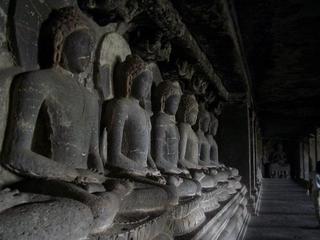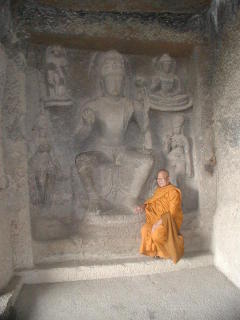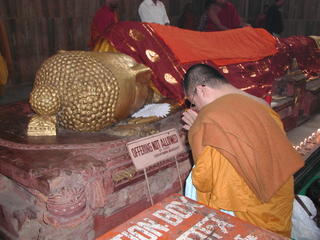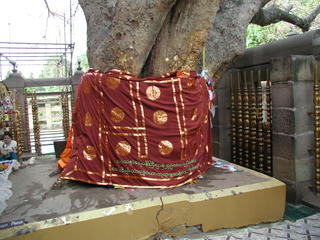




Handy monk is a Thai monk lives in WatThai,D.C. and have serving the Thai& American society in metropolitan area. He lives in the United States since 1992.

The
The Ellora temple caves are used for worship by different religions, namely Buddhism, Hinduism, and Jainism. These caves are a mile and a quarter long. They are located about eighteen and a half miles from the city of
The Ellora caves, which date from the period 9 to 12 A.D., were constructed later than the
The most beautiful of the Ellora caves is the tenth. It is two stories high with a pagoda inside. The top floor has a large arched balcony extending outwards. There are stone carvings of hovering devas on the exterior face of the cave. The ceiling is a Sanchi-style dome. In the stupa there is a large Buddha image.
The eleventh and twelfth caves, which are considered to be more important than the other caves, are three stories high. Each story consists of a large residence hall (vihara) that the monks used. The monks’ cells extend off from the halls. The viharas are decorated with large columns and include balconies. Each top story, which contains many Buddha images lined up in a row, has a large Buddha sculpture. The fourth cave is currently used for Dhamma study, and the twelfth for merit ceremonies and as a monks’ quarters.
The seventeenth cave was the Hindu cave. The Hindu people wanted their caves to be a treasure of Hindu religion. They constructed caves thirteen through twenty-nine.
It was well known that the sixteenth cave, the Kailash cave, was the most beautiful of all the Ellora caves. This cave was carved from top to bottom out of a mountain. Altogether the stone that was removed weighed about 200,000 tons. The stone was carved into a very large and very beautiful Hindu-style temple. Around the temple walls and doors there are various forms of the Hindu god (tavathas) with his consort. Inside what was the monks’ residence is a large Shiva-lincum (phallus). On the ceiling of the temple is a carving of a lotus. Many Hindu people come here to worship. When they enter they feel that they are connected with their ancestors. Because the temple cave is so enormous, in every direction there are stone carvings of Hindu tavathas miles long.
When the Jains were in power, they built caves that modeled the caves the Buddhists and Hindus had built. This is especially true of the thirty-second Jain cave. This temple cave contains a stone carving of Mahavira sitting in the meditation position under a banyan tree. Another carving depicts a naked male standing with a vine wrapped around his arms and legs. However, all thirty-four caves have carving of devas at the ceiling angles, as well as carvings covering the columns with large lotus petals at the capitals of the columns.
By PhramahaThanat Inthisan Ph.D.
Edited by Duwayne




The Great Sanchi Stupa
The great Sanchi stupa looks like a huge bowl placed upside down. It has been well known since ancient times. Built between the years 200 B.C. to 200 A.D., it is the oldest stone structure from the era of Great King Asoka. The ancient hill of Sanchi was called Shikiri City of Jetiyakiri, jetiyakiri meaning the mountain with the pagoda on top. The Sanchi stupa is located in the Madhya Pradesh (state) in central
The ancient hill of Sanchi was in proximity to Ujayni, the capital city of
The stupa is well preserved to this day. It is constructed of rectangular-shaped stones lined up in rows. It is about 120 feet in diameter and about 52.5 feet in height. The stupa is topped by a ceremonial umbrella (chatta). The area around the stupa is quite large and enclosed by stone balustrades. These balustrades are curved, designed to conform to the shape of the stupa. They are known as King Asoka Fence. All four entrances to the stupa have stone carvings of the Buddha depicting different periods of his life. There are carvings of the birth of the Buddha, Lumpini Grove where he was born, his reaching Enlightenment, his preaching the Dhamma, his leaving the palace to become a monk, and his passing into Nirvana. There are carvings of the Buddha converting the three ascetics. Another scene shows his relics being divided among the eight cities. There are even carvings which illustrate the lifestyles of the people of the time.
Two small stupas were subsequently constructed on either side of the larger one. The one on the right was built to enshrine the venerable Sariputta’s relics. The other small stupa on the left contains the venerable Maha Moggallana’s relics. The venerable Sariputta and the venerable Maha Moggallana were the Buddha’s chief disciples. There was also a sangkaram (temple, wat) at the rear. Another stupa at the temple holds the relics of Mokkalibutisa Thera, Great King Asoka’s teacher and the abbot of the temple, as well as the relics of arahants respected by the king.
Near the great stupa at the wat there was a Dhamma hall used for religious ceremonies. Only remnants of this building remain, including the bases of the stone columns. At the front of the great stupa there was a monolithic pillar, now broken. A long section of the pillar is now on the ground where the monks’ residence hall (vihara) used to be at the temple. The inscription on the piece of pillar states the following: “If anyone moves or destroys this stone pillar, that person will be punished.” The inscription warned that anyone tampering with the pillar was committing a sin.
Edited by Duwayne








